#American Naturalist artist
Explore tagged Tumblr posts
Text

John LaFarge, "Agathon to Erosanthe-votive wreath", oil on canvas, 1861. American Naturalist artist 1835–1910.
#John LaFarge#Agathon to Erosanthe-votive wreath#1861#oil on canvas#oil painting#painting#art#American Naturalist artist#1835–1910#flowers#nature
39 notes
·
View notes
Text

Happy Nation Bison Day !
Source Me laf@ilyF ❤️
#artists on tumblr#original photographers#photographers on tumblr#photography#my photgraphy#colors#oklahoma#Prairie's#American Bison#wildlife#wildlife photography#Wichita Mountain Wildlife Refuge#naturalist
17 notes
·
View notes
Text

John James Audubon (born Jean-Jacques Rabin, French-American, 1785-1851)
#illustration#art#john james audubon#naturalist#botanical illustration#ornithology#ornithologist#orthithological illustration#self-taught artist#french-american artist#sassafras and moonshine
14 notes
·
View notes
Photo




John James Audubon
The Birds of America, from Drawings made in the United States and their Territories. New York: J. J. Audubon, Philadelphia: J. B. Chevalier, [1839‒] 1840‒1844
#John James Audubon#John James Audubon The Birds of America 1840‒1844#american artist#naturalist#ornithologist#art#artist#art work#art world#art news#birds
10 notes
·
View notes
Text










A Pigeon-fluencer Feathursday
This week’s post was inspired by a recent Guardian article on the rise of Pigeon-influencers on TikTok and their role in reviving the popularity of the oft-derided and underestimated birds.
Throughout history, pigeons have provided sustenance (“squab”), labor (in the form of the “pigeon post”), and companionship to human populations. Though these days we may typically associate the Rock Pigeon (Columba livia, otherwise known as the common pigeon) with other animals classified as “pests” in urban landscapes, they are in fact understood to be the world's oldest domesticated bird. Historical documentation of pigeons can be found in hieroglyphic texts and art dating back as far as ancient Egypt and Mesopotamia. According to Colin Jerolmack, professor of Sociology and Environmental Studies at NYU and author of The Global Pigeon, pigeons “have been in cities as long as we’ve had cities” and, prior to the technological innovation of the telegram, were “the most reliable messaging system in the world��. While “fancy” pigeons (like Frillbacks, English Magpies, Jacobin, and Archangel pigeons) were bred and kept as prized pets in the Victorian era, the North American Passenger Pigeon (or “wild pigeon”) was hunted to the point of extinction in the early 20th century.
To illustrate the complexity of our love-hate relationship with the birds we've selected a variety of illustrations and text from our collection and featured them alongside some images from outside sources.
The engravings in images #2 & #8 from The Illustrated Natural History: Birds (London: George Routledge & Sons) were created by the Brothers Dalziel, a wood engraving shop in Victorian London founded in 1839 and operated by George and Edward Dalziel. Image #1 from Birds of America; Fifty Selections (with commentaries by Roger Tory Peterson) (New York: Macmillan) is a reproduction of a hand-colored lithograph produced by the shop of J. T. Bowen of Philadelphia from a painting by naturalist and artist John James Audubon in the early 19th century.
--Ana, Special Collections Graduate Intern
Other image sources:
#3: Western Crowned Pigeon (Goura cristata) in TMII Birdpark - Western crowned pigeon - Wikipedia
#4: Keyla Rose with Tony, her pigeon, on a walk in New York. Photograph: Alaina Demopoulos/The Guardian. August 23, 2024.
#5-6: from City Creatures: Animal Encounters in the Chicago Wilderness Pigeons (poem) by Chicago-based Puerto Rican poet and community activist David Hernandez, DH+BH (image of tattoo) by Camilo Cumpian.
#7: Ceiling Fragment Depicting Pigeons in Flight | New Kingdom | The Metropolitan Museum of Art (metmuseum.org) (ca. 1390–1352 B.C.)
#9: a Memorial to the extinct Passenger Pigeon at Wyalusing State Park in Wisconsin (1947)
#10: from Nikola Tesla's Obsession with Pigeons, Electricity, and a Plan to Wirelessly Connect the World (nautil.us)
#pigeons#pigeonfluencers#feathursday#Rock Dove#special collections#engraving#wood engraving#lithograph#hand colored#tiktok#pigeontok#John James Audobon#City Creatures#David Hernandez#Camilo Cumpian#Colin Jerolmack#nikola tesla#Brothers Dalziel#George Routledge & Sons#The Illustrated Natural History: Birds#Birds of America
62 notes
·
View notes
Text
Coral today is an icon of environmental crisis, its disappearance from the world’s oceans an emblem for the richness of forms and habitats either lost to us or at risk. Yet, as Michelle Currie Navakas shows in [...] Coral Lives: Literature, Labor, and the Making of America, our accounts today of coral as beauty, loss, and precarious future depend on an inherited language from the nineteenth century. [...] Navakas traces how coral became the material with which writers, poets, and artists debated community, labor, and polity in the United States.
The coral reef produced a compelling teleological vision of the nation: just as the minute coral “insect,” working invisibly under the waves, built immense structures that accumulated through efforts of countless others, living and dead, so the nation’s developing form depended on the countless workers whose individuality was almost impossible to detect. This identification of coral with human communities, Navakas shows, was not only revisited but also revised and challenged throughout the century. Coral had a global biography, a history as currency and ornament that linked it to the violence of slavery. It was also already a talisman - readymade for a modern symbol [...]. Not least, for nineteenth-century readers in the United States, it was also an artifact of knowledge and discovery, with coral fans and branches brought back from the Pacific and Indian Oceans to sit in American parlors and museums. [...]
---
[W]ith material culture analysis, [...] [there are] three common early American coral artifacts, familiar objects that made coral as a substance much more familiar to the nineteenth century than today: red coral beads for jewelry, the coral teething toy, and the natural history specimen. This chapter [...] [brings] together a fascinating range of representations of coral in nineteenth-century painting and sculptures.
With the material presence of coral firmly in place, Navakas returns us to its place in texts as metaphor for labor, with close readings of poetry and ephemeral literature up to the Civil War era. [...] [Navakas] includes an intriguing examination of the posthumous reputation of the eighteenth-century French naturalist Jean-André Peyssonnel who first claimed that coral should be classed as an animal (or “insect”), not plant. Navakas then [...] considers white reformers [...] and Black authors and activists, including James McCune Smith and Frances Ellen Watkins Harper, and a singular Black charitable association in Cleveland, Ohio, at the end of the century, called the Coral Builders’ Society. [...]
---
[H]er attention to layered knowledge allows her to examine the subversions of coral imagery that arose [...]. Obviously, the mid-nineteenth-century poems that lauded coral as a metaphor for laboring men who raised solid structures for a collective future also sought to naturalize a system that kept some kinds of labor and some kinds of people firmly pressed beneath the surface. Coral’s biography, she notes, was “inseparable from colonial violence at almost every turn” (p. 7). Yet coral was also part of the material history of the Black Atlantic [...].
Thus, a children’s Christmas story, “The Story of a Coral Bracelet” (1861), written by a West Indian writer, Sophy Moody, described the coral trade in the structure of a slave narrative. [...] In addition, coral’s protean shapes and ambiguity - rock, plant, or animal? - gave Americans a model for the difficulty of defining essential qualities from surface appearance, a message that troubled biological essentialists [...]. Navakas thus repeatedly brings into view the racialized and gendered meanings of coral [...].
---
Some readers from the blue humanities will want more attention, for example, to [...] different oceans [...]: Navakas’s gaze is clearly eastward to the Atlantic and Mediterranean and (to a degree) to the Caribbean [...], even though much of the natural historical explorations, not to mention the missionary interest in coral islands, turns decidedly to the Pacific. [...] First, under my hat as a historian of science, I note [...] [that] [q]uestions about the structure of coral islands among naturalists for the rest of the century pitted supporters of Darwinian evolutionary theory against his opponents [...]. These disputes surely sustained the liveliness of coral - its teleology and its ambiguities - in popular American literature. [...]
My second desire, from the standpoint of Victorian studies, is for a more specific account of religious traditions and coral. While Navakas identifies many writers of coral poetry and fables, both British and American, as “evangelical,” she avoids detailed analysis of the theological context that would be relevant, such as the millennial fascination with chaos and reconstruction and the intense Anglo-American missionary interest in the Pacific. [...] [However] reasons for this move are quickly apparent. First, her focus on coral as an icon that enabled explicit discussion of labor and community means that she takes the more familiar arguments connecting natural history and Christianity in this period as a given. [...] Coral, she argues, is most significant as an object of/in translation, mediating across the Black Atlantic and between many particular cultures. These critical strategies are easy to understand and accept, and yet the word - the script, in her terms - that I kept waiting for her to take up was “monuments”: a favorite nineteenth-century description of coral.
Navakas does often refer to the awareness of coral “temporalities” - how coral served as metaphor for the bridges between past, present, and future. Yet the way that a coral reef was understood as a literal graveyard, in an age that made death practices and new forms of cemeteries so vital a part of social and civic bonds, seems to deserve a place in this study. These are a greedy reader’s questions, wanting more. As Navakas notes [...], the method [...] is to understand our present circumstances as framed by legacies from the past, legacies that are never smooth but point us to friction and complexity.
---
All text above by: Katharine Anderson. "Review of Navakas, Michele Currie, Coral Lives: Literature, Labor, and the Making of America." H-Environment, H-Net Reviews. December 2023. Published at: [networks.h-net.org/group/reviews/20017692/anderson-navakas-coral-lives-literature-labor-and-making-america] [Bold emphasis and some paragraph breaks/contractions added by me. Presented here for commentary, teaching, criticism.]
#ecologies#tidalectics#multispecies#geographic imaginaries#ecology#archipelagic thinking#interspecies
96 notes
·
View notes
Text
Bestiaryposting Results: Gibemlut
All right, so we've got another bird, let's see what we're doing with it. Preliminaries, though:
If you don't know what this is about, check https://maniculum.tumblr.com/bestiaryposting.
The art in this post is based on a bestiary entry which can be found here:
If you want to participate yourself for next week, that entry can be found here:
Now, art below the cut.

@silverhart-makes-art (link to post here) notes the lack of physical description in the entry, and has based their interpretation on the American Robin. For why, and other details about the design, see the linked post. I rather like the speckles, and I think the large eyes make it pretty cute.

@cheapsweets (link to post here) observes the kind of nonsensical parts of the entry and then provides us with this very nice rendering of a singing bird. I think the pilgrim in the background is a nice touch. I recommend checking the linked post for further discussion. (Also thank you for providing alt text.)

@pomrania (link to post here) also makes note of the nonsensical parts of the entry at some length in their progress thread -- worth checking out if you're curious -- and landed on this design. I think it's a pretty solid not-quite-a-chicken.

@strixcattus (link to post here) is the third to make note of the way this entry doesn't make sense. She has drawn this songbird with a very nice color palette and a facial expression that I'm not sure what to make of. As always, see the linked post for a modern naturalistic description of the creature in question.

@wendievergreen (link to post here) joins the chorus of "how is something with no external testicles being castrated", and has also drawn some excellent birds. I continue to really enjoy their art style -- I like how the birds here almost look like they're wearing masks. (Also, thank you for including alt text.)

@coolest-capybara (link to post here) has similar concerns to our other artists, as well as a different, more disturbing interpretation of the business with the liquid gold. (That sentence is grammatically ambiguous, now that I think of it.) As always, their artistic contribution is fantastically stylized, and predictably, I enjoy the tree. The potoo influence, I think, also really works here.
Can't go to the Aberdeen Bestiary this time -- this is another entry where the picture has been cut out -- so here's the version from the Ashmole Bestiary.

Yep, that's pretty clearly a rooster.
Well, it's blue, but I don't know that there are no blue roosters.
Honestly I don't have a lot to add here, except that it's fascinating and kind of sweet that the medieval author thought of the calls of chickens that way.
This also puts a whole new spin on the castration thing -- do any chicken owners out there have some idea why people would describe roosters as being castrated? Do people castrate them? How?
(I continue to have no explanation for the gold thing.)
22 notes
·
View notes
Text
Silver Horn drawings, 1897-1921

Silver Horn drawings, 1897-1921
“Silver Horn (1860-1940), a Kiowa artist from the early reservation period, may well have been the most prolific Plains Indian artist of all time. Known also as Haungooah, his Kiowa name, Silver Horn was a man of remarkable skill and talent. Working in graphite, colored pencil, crayon, pen and ink, and watercolor on hide, muslin, and paper, he produced more than one thousand illustrations between 1870 and 1920. Silver Horn created an unparalleled visual record of Kiowa culture, from traditional images of warfare and coup counting to sensitive depictions of the sun dance, early Peyote religion, and domestic daily life. At the turn of the century, he helped translate nearly the entire corpus of Kiowa shield designs into miniaturized forms on buckskin models for Smithsonian ethnologist James Mooney.”
-- Silver Horn: Master Illustrator of the Kiowas by Candace S. Greene
The artist Elbridge Ayer Burbank traveled to Indian reservations in the late nineteenth century to paint the portraits of Indigenous peoples. Burbank traveled to Fort Sill, Oklahoma, on three occasions; it was there that the Kiowa artist Silver Horn sat for him for at least two portraits.
Silver Horn had been an established artist among the Kiowa since the 1880s. In 1899, he became interested in Burbank’s “naturalist” technique, and he observed the American artist as he painted other subjects. With Burbank, Silver Horn studied the art of modeling faces and individual portraiture. He experimented with this style in a series of individual portraits of people and animals, most of which he sold to Edward E. Ayer, before abandoning the style in favor of work that was more stylistically Kiowa.
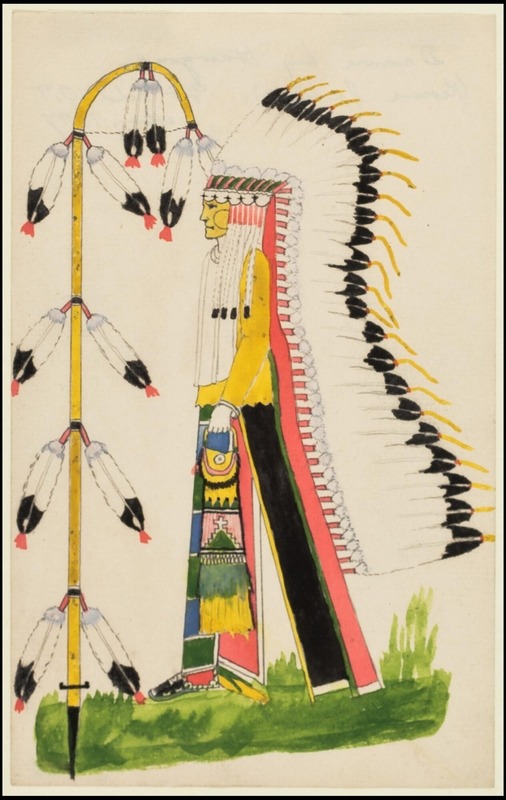
Silver Horn drawings, 1897-1921
The 123 pieces by Silver Horn in the Newberry’s Ayer Collection demonstrate that his experimentation took him away from narratives about community to work that featured individuals. This makes the body of work held in the collection stylistically distinct from both the earlier and later periods of Silver Horn's work.
–former Ayer Reference Librarian Seonaid Valiant (abridged from original post)
View Silver Horn's drawings or all of the Edward E. Ayer Collection at Newberry Digital Collections
#newberry library#libraries#special collections#archives#native american history#native american art#silver horn#kiowa#collection stories
106 notes
·
View notes
Text










Thomas Hart Benton (1889-1975, American)
Born in Missouri into a politically influential family in 1889, Benton found inspiration among working class communities in rural America. A prolific painter, sculptor, printmaker and gifted storyteller, Benton is credited with leading the Regionalist movement in the United States early in his career. He has long been celebrated as the most innovative practitioner of mural painting depicting American life.
Benton studied at prestigious institutions including the Art Institute of Chicago in 1907 and the Académie Julian in Paris, where he met fellow American painter, Synchromist Stanton Macdonald-Wright. Settling in New York in 1911, Benton’s work remained largely abstract until the early 1920s. On a 1924 trip home to visit his father, he was inspired to revisit his midwestern roots and began painting American rural subjects such as life in coal mines, steel mills and cotton fields. The influence of Spanish Old Master El Greco is evident in Benton’s naturalistic style, sculpted figures and fluid lines. While the rhythmic distortions of Benton’s compositions were informed by his European study, his work reflects a vibrant diversity that is distinctly American.
Benton was the first artist to be featured on the cover of Time magazine and his murals hung at an early site of the Whitney Museum of American Art. It was during this time that Benton formed a close alliance with his student - and frequent guest at his Martha’s Vineyard studio - Jackson Pollock.
https://schoelkopfgallery.com/art.../129-thomas-hart-benton/
23 notes
·
View notes
Note
Fav horror movie recommendations if you feel like sharing? I try to watch one a day in Oct and my list is a little light this year!
Hi hi hi I'm gonna be obnoxious and recommend a few of varying moods!! (. ❛ ᴗ ❛.)

1.) Ring

One of the main inspirations for the J-Horror boom in the early 2000's, Ring (often referred to as "Ringu") is a moody suspense flick with aspirations towards solving the mystery of a mysterious curse transmitted via VHS tape.
Based on the novel by Koji Suzuki, Ring captures the mood and tone of the book much moreso than the American Remake (which as far as American remakes go is loud but fine) and has a few stand out moments. It's definitely a favorite of mine.
CW: Child Abuse, Mild Body Horror
Liked this? Check out: Ju-On 2, Ring 0, and One Missed Call.
2.) Sleepaway Camp
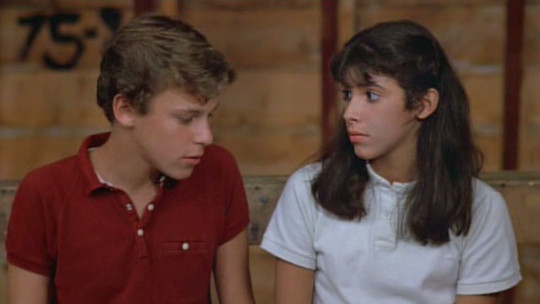
Definitely not a popular pick, Sleepaway Camp is a typical summer camp slasher (as was the style at the time) and holds up shockingly well*** all things considered! (We'll get to the asterisk in the CW)
Sleepaway Camp is carried by odd, earnest, and fun performances, the kids are kids who yell, swear, and are silly, the adults are either Shakespearean or complete planks of wood, and they all bounce off each other with really naturalistic and hysterical dialogue, it's very quotable. A great fun time with friends. BUT...
CW: Spoilers! Transphobia, the entire film has trickles of mild queer symbolism in some dream sequences, but the big ending reveal is that surprise! The killer is trans! And that is depicted as being more horrifying than the decapitated head they're holding. In the queer lens I view this in today it's quite a fun film with a lot of revenge kills but it's still, in the text and to the mass audience, it's quite a Hallmark of pop culture transphobia. Take is or leave is.
Like this? Check out: Basket Case, Nightmare on Elm Street 2, Cabin in the Woods (I don't like that one but it tends to be loved by most who watch it)
3.) Us
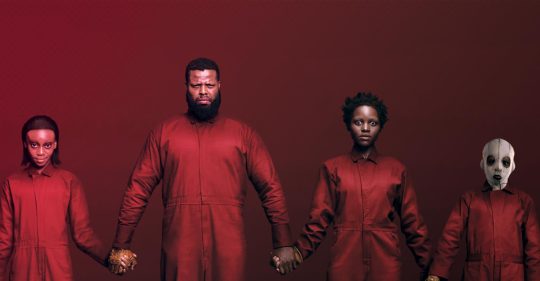
Something more contemporary, more artistic, and honestly funny, Us by Jordan Peele is a very interesting high concept film, and his second overall. The concept of the doppelganger is not new, but to see it plain as day, so well executed is super interesting to see properly.
Us gets a lot of flack for being a bit more bloated and messy compared to other Peele films, but I like to think of the looseness of the rules and the bleakness of the metaphor to be very engaging and beautiful
CW: General violence
Like this? Check out: Nope, Get Out, Uzumaki (yes actually, I think they have a similar situation of an unnatural and bleak conflict that can't really be solved)
4.) La Casa Lobo

Where the fuck do I start with this one, La Casa Lobo is in universe, a propaganda-y children's story for a midsommar ass cult, and it is as beautiful as it is horrifying. This stop motion, paper maché, charcoal nightmare is always moving, always uncanny, and always isolating. It's phenomenal, and while it's premise may be simple, entering the wolf house will make you feel like you can't leave.
CW: animal violence, child endangerment, it's uncanny as fuck.
Like this? Check out: Mad God, Guillermo del Toro's Pinocchio, Midsommar
4.) [•REC]

This Spanish found footage "zombie" movie is a blast from start to end with great pacing. Not so much a story as it is more of a "things happening" movie, [•REC] never fails to deliver on the tension or scares. I have a soft spot for the film, as I saw it as a kid with my folks IN PARTS on YouTube like a fucking anime
If that doesn't age me I don't know what will.
CW: Child death, particularly jumpscarey, gore and body horror
Like this? Check out: [•REC2] (think Aliens compared to Alien), The Mandela Catalogue (yes really), Quarantine (American Remake that's not, terrible?)
5.) heck/Skinamarink
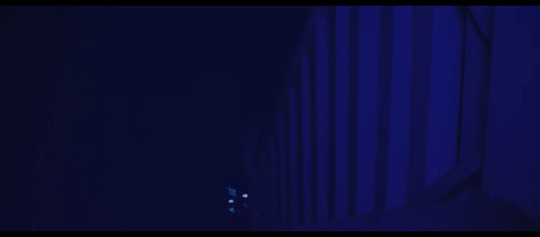
Predecessor to recent indie smash hit, Skinamarink, heck is the litmus test as to whether or not you can stomach Skinamarink. Slow, creeping, exclusively diagetic, and immensely creepy. There is little plot, and it's again an experience, but one that feels like a living breathing Nightmare.
The reason heck is here first instead of Skinamarink, is mainly length vs quality vs density. Skinamarink is a very good picture but for the average person it wears out it's welcome by the 1 hour mark, and we still got like 40 min to go. heck is a bite sized 30 minute short film that just gets to the point quicker. However with the reduced runtime, you lose the density of the atmosphere. It's both better but lesser. Both heck and Skinamarink are fine movies, but definitely pick which one you wanna see based on the mood of the evening and your company
CW: body horror, child endangerment (lot of that on this list)
Like this? Check out: Paranormal Activity, The Mandela Catalogue, Vita Carnis
Other Curiosities worth exploring
The Cabinet of Dr. Calagari - it's the first, it's beautiful, and still an admirable work of art to this day, around 100 years later
Gojira - while the character is nowadays more of an action property, the original Gojira is still incredibly harrowing
Tetsuo the Iron Man - loud, intense, and metal as fuckkk. Tetsuo is a more surreal extreme horror movie full of body horror and antagonistic sound design
Chainmail Chasers - a quaint horror series based off of the old smiledog creepypasta. Considering it's just like one gal and her friends it's very impressive, still in progress
Local 58 - a well regarded foreboding horror series regarding mysteries around the moon and how that relates to the local news station
Okay that's it sorry bYE!! (・∀・)
#succubushotmilk#skeleasks#horror reccomendations#horror films#bones rattle#ring#the ring#ringu#sleepaway camp#us#us 2019#la casa lobo#the wolf house#rec#•rec#[•rec]#heck#skinamarink#these are just my reccomendations#add more or roast me in the comments etc etc#i dont have a lot of game knowledge but i always say silent hill 2 resi 4 and while not horror strictly yume nikki#its a good time whenever tbh
73 notes
·
View notes
Text
#WatercolorWednesday:
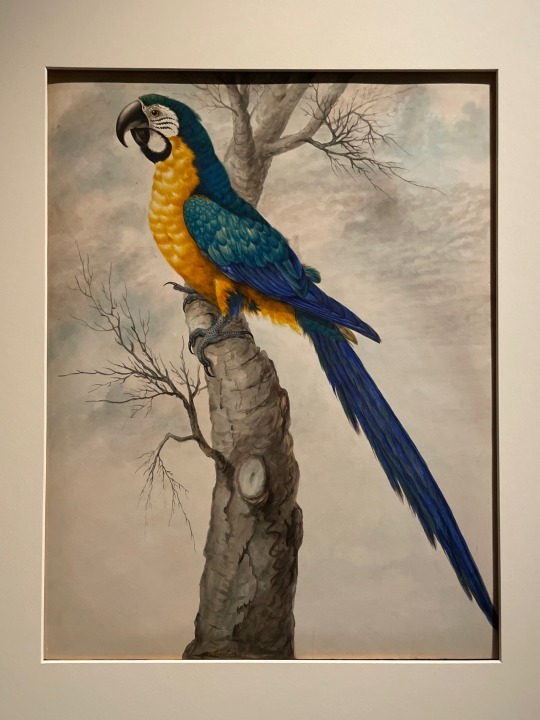
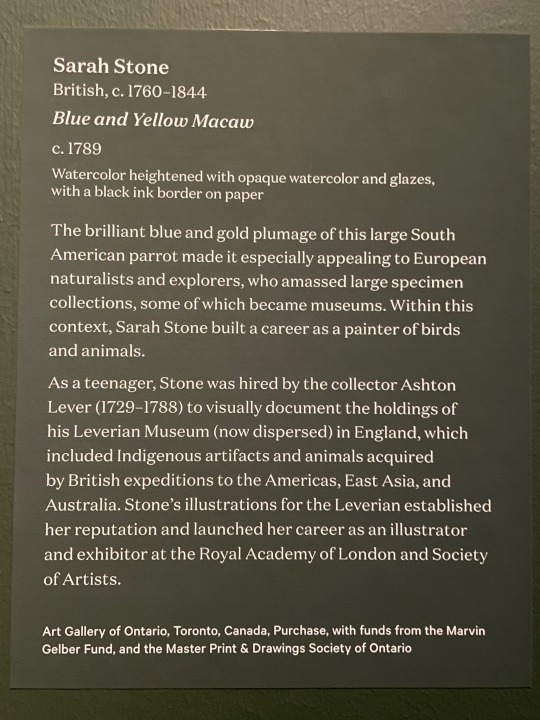
Sarah Stone (British, c. 1760-1844)
Blue and Yellow Macaw, c.1789
Watercolor heightened with opaque watercolor & glazes, with black ink border on paper
on display at “Making Her Mark: A History of #WomenArtists in Europe, 1400-1800” exhibition at Baltimore Museum of Art
“The brilliant blue and gold plumage of this large South American parrot made it especially appealing to European naturalists and explorers, who amassed large specimen collections, some of which became museums. Within this context, Sarah Stone built a career as a painter of birds and animals.
As a teenager, Stone was hired by the collector Ashton Lever (1729-1788) to visually document the holdings of his Leverian Museum (now dispersed) in England, which included Indigenous artifacts and animals acquired by British expeditions to the Americas, East Asia, and Australia. Stone's illustrations for the Leverian established her reputation and launched her career as an illustrator and exhibitor at the Royal Academy of London and Society of Artists.”
#animals in art#european art#museum visit#bird#birds#birds in art#parrot#parrots#macaw#Blur and Gold Macaw#Blue and Yellow Macaw#Sarah Stone#women artists#women in science#exhibition#18th century art#British art#natural history art#scientific illustration#Baltimore Museum of Art#watercolor#painting#ornithology#ornithological illustration
26 notes
·
View notes
Text


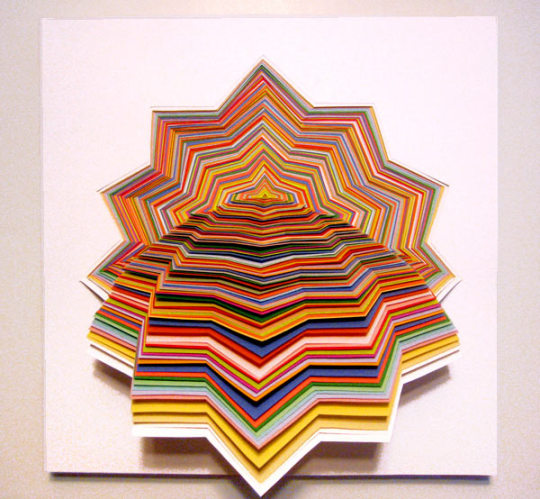

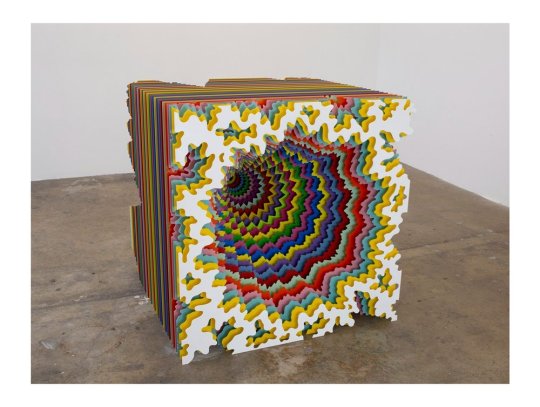
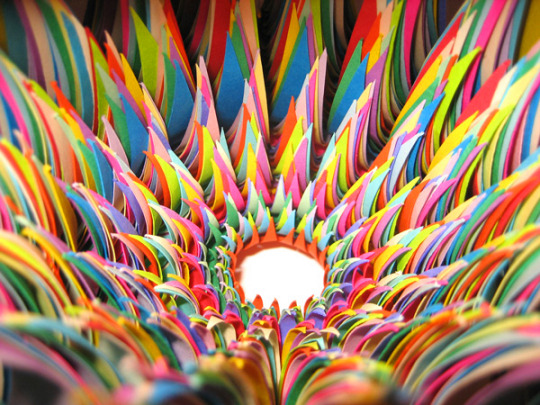

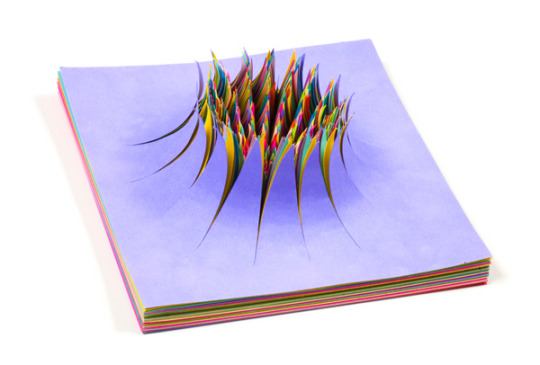

Jen Stark’s art is driven by her interest in conceptualizing visual systems to simulate plant growth, evolution, infinity, fractals, mimetic topographies, and sacred geometries. Using available materials—paper, wood, metal, paint—Stark strives to make work that balances on a razor’s edge of optical seduction and perceptual engagement. In recent years, Stark has introduced new technologies into her diverse practice, delving into the digital realm of interactive projections and distinctive NFTs.
The resulting works often resemble organic, molecular, cloud-like structures, and are imbued with kinetic, undulating effects that serve to dislocate the viewer from staid reality into an immersive ecosphere of echoing patterns and the implausible designs found in nature. Even her vivid colors are in direct conversation with the natural world; the attractant/repellent properties of flowers encouraging pollination or insects warning birds of their poisonous traits, and the luminous mystery of phosphorescent sea creatures are among Stark’s concerns.
Via these corporeal abstractions, spectators are led onto the astral plane; there’s a transcendence to Stark’s work where the vibrational phases become a sacrosanct and curative experience for the viewer. Traces of mandalas or nautili reveal themselves as sacred geometric forms in Stark’s spiritual reservoir.
Stark’s ability to create atmospheric, minimal, naturalist configurations that only reveal themselves after deep engagement align her with the artistic legacies of Yayoi Kusama, Sol Lewitt, Tara Donovan, Tom Friedman, Andy Goldsworthy, Ernst Haeckel, and the Finish Fetish artists of 1960s Los Angeles.
Not limited to the confines of museums and galleries, Stark’s diverse practice—a series of sculptural objects that rely on a commitment to process and hypnotic repetition; charismatic wall works; widely seen murals; intricately animated films; NFTs (non-fungible tokens) and interactive projections—has been exhibited throughout the world, permeating both the physical and digital realms. By adopting cutting-edge techniques to showcase her aesthetic, Stark activates her universe through constant adaptation and transformation.
Stark was born in Miami, Florida in 1983, and studied at the Maryland Institute College of Art, graduating in 2005. Since then, Stark has realized exhibitions globally, with major shows in New York, Los Angeles, Miami, Chicago, Thailand, and Canada. Recently included as one of Fortune’s “NFTy 50,” Stark made history as the first female artist to make Foundation’s top 10 highest selling NFT creatives. Her work is in the collections of the Smithsonian American Art Museum, the West Collection, Crystal Bridges Museum of American Art, NSU Art Museum and MOCA Miami, among others.
Stark lives and works in Los Angeles. Part1 Part2
#sculpture #sculptureart #sculptureartist #sculptures #sculpturelovers #sculptureoftheday #sculpturepark #sculpture_art #sculpturegallery #sculpturesofinstagram #sculpture_gallery #sculpturesurbois #contemporarysculpture #sculpturecontemporaine #sculpturephotography #sculptured #modernsculpture #abstractsculpture #handsculpture @frenchpsychiatrymuderedmycnut 🌈 #artsculpture #instasculpture #skulptur #skulpturen #skulpturer #skulpturensammlung #skulptures #skulptūra #skulpturia #skulpturenausstellung
Soundtrack: I Feel Space by Lindstrøm 🌈

#l o v e#Jen Stark#5/2023#artist of the day#Pop art#rainbow#rainbow warriors#sculptor#sculptures#female artists#female artwork#female art#newcontemporary#new contemporary#new contemporary art#x-heesy#fucking favorite#now playing#music and art#contemporaryart#🌈#symmetry#pattern
95 notes
·
View notes
Text

LETTERS FROM AN AMERICAN
April 7, 2024 (Sunday)
HEATHER COX RICHARDSON
APR 08, 2024
In August 1870 a U.S. exploring expedition headed out from Montana toward the Yellowstone River into land the U.S. government had recognized as belonging to different Indigenous tribes.
By October the men had reached the Yellowstone, where they reported they had “found abundance of game and trout, hot springs of five or six different kinds…basaltic columns of enormous size” and a waterfall that must, they wrote, “be in form, color and surroundings one of the most glorious objects on the American Continent.” On the strength of their widely reprinted reports, the secretary of the interior sent out an official surveying team under geologist Ferdinand V. Hayden. With it went photographer William Henry Jackson and fine artist Thomas Moran.
Banker and railroad baron Jay Cooke had arranged for Moran to join the expedition. In 1871 the popular Scribner’s Monthly published the surveyor’s report along with Moran’s drawings and a promise that Cooke’s Northern Pacific Railroad would soon lay tracks to enable tourists to see the great natural wonders of the West.
But by 1871, Americans had begun to turn against the railroads, seeing them as big businesses monopolizing American resources at the expense of ordinary Americans. When Hayden called on Congress to pass a law setting the area around Yellowstone aside as a public park, two Republicans—Senator Samuel Pomeroy of Kansas and Delegate William H. Clagett of Montana—introduced bills to protect Yellowstone in a natural state and provide against “wanton destruction of the fish and game…or destruction for the purposes of merchandise or profit.”
The House Committee on Public Lands praised Yellowstone Valley’s beauty and warned that “persons are now waiting for the spring…to enter in and take possession of these remarkable curiosities, to make merchandise of these bountiful specimens, to fence in these rare wonders so as to charge visitors a fee, as is now done at Niagara Falls, for the sight of that which ought to be as free as the air or water.” It warned that “the vandals who are now waiting to enter into this wonderland will, in a single season, despoil, beyond recovery, these remarkable curiosities which have required all the cunning skill of nature thousands of years to prepare.”
The New York Times got behind the idea that saving Yellowstone for the people was the responsibility of the federal government, saying that if businesses “should be strictly shut out, it will remain a place which we can proudly show to the benighted European as a proof of what nature—under a republican form of government—can accomplish in the great West.”
On March 1, 1872, President U. S. Grant, a Republican, signed the bill making Yellowstone a national park.
The impulse to protect natural resources from those who would plunder them for profit expanded 18 years later, when the federal government stepped in to protect Yosemite. In June 1864, Congress had passed and President Abraham Lincoln signed a law giving to the state of California the Yosemite Valley and nearby Mariposa Big Tree Grove “upon the express conditions that the premises shall be held for public use, resort and recreation.”
But by 1890 it was clear that under state management the property had been largely turned over to timber companies, sheep-herding enterprises, and tourist businesses with state contracts. Naturalist John Muir warned in the Century magazine: “Ax and plow, hogs and horses, have long been and are still busy in Yosemite’s gardens and groves. All that is accessible and destructible is rapidly being destroyed.” Congress passed a law making the land around the state property in Yosemite a national park area, and the United States military began to manage the area.
The next year, in March 1891, Congress gave the president power to “set apart and reserve…as public reservations” land that bore at least some timber, whether or not that timber was of any commercial value. Under this General Revision Act, also known as the Forest Reserve Act, Republican president Benjamin Harrison set aside timber land adjacent to Yellowstone National Park and south of Yosemite National Park. By September 1893, about 17 million acres of land had been put into forest reserves. Those who objected to this policy, according to Century, were “men [who] wish to get at it and make it earn something for them.”
Presidents of both parties continued to protect American lands, but in the late nineteenth century it was New York Republican politician Theodore Roosevelt who most dramatically expanded the effort to keep western lands from the hands of those who wanted only their timber and minerals.
Roosevelt was concerned that moneygrubbing was eroding the character of the nation, and he believed that western land nurtured the independence and community that he worried was disappearing in the East. During his presidency, which stretched from 1901 to 1909, Roosevelt protected 141 million acres of forest and established five new national parks.
More powerfully, he used the 1906 Antiquities Act, which Congress had passed to stop the looting and sale of Indigenous objects and sites, to protect land. The Antiquities Act allowed presidents to protect areas of historic, cultural, or scientific interest. Before the law was a year old, Roosevelt had created four national monuments: Devils Tower in Wyoming, El Morro in New Mexico, and Montezuma Castle and Petrified Forest in Arizona.
In 1908, Roosevelt used the Antiquities Act to protect the Grand Canyon.
Since then, presidents of both parties have protected American lands. President Jimmy Carter rivaled Roosevelt’s protection of land when he protected more than 100 million acres in Alaska from oil development. Carter’s secretary of the interior, Cecil D. Andrus, saw himself as a practical man trying to balance the needs of business and environmental needs but seemed to think business interests had become too powerful: “The domination of the department by mining, oil, timber, grazing and other interests is over.”
In fact, the fight over the public lands was not ending; it was entering a new phase. Since the 1980s, Republicans have pushed to reopen public lands to resource development, maintaining even today that Democrats have hampered oil production although it is currently, under President Joe Biden, at an all-time high.
The push to return public lands to private hands got stronger under former president Donald Trump. On April 26, 2017, Trump signed an executive order—Executive Order 13792—directing his secretary of the interior, Ryan Zinke, to review designations of 22 national monuments greater than 100,000 acres, made since 1996. He then ordered the largest national monument reduction in U.S. history, slashing the size of Utah’s Bears Ears National Monument by 85%—a goal of uranium-mining interests—and that of Utah’s Escalante–Grand Staircase by about half, favoring coal interests.
“No one better values the splendor of Utah more than you do,” Trump told cheering supporters. “And no one knows better how to use it.”
In March 2021, shortly after he took office, President Biden announced a new initiative to protect 30% of U.S. land, fresh water, and oceans areas by 2030, a plan popularly known as 30 by 30. Also in March 2021, Supreme Court chief justice John Roberts urged opponents of land protection to push back against the Antiquities Act, saying the broad protection of lands presidents have established under it is an abuse of power.
In October 2021, President Biden restored Bears Ears and Escalante–Grand Staircase to their original size. “Today’s announcement is not just about national monuments,” Interior Secretary Deb Haaland, a member of the Laguna Pueblo in New Mexico, said at the ceremony. “It’s about this administration centering the voices of Indigenous people and affirming the shared stewardship of this landscape with tribal nations.”
In 2022, nearly 312 million people visited the country’s national parks and monuments, supporting 378,400 jobs and spending $23.9 billion in communities within 60 miles of a park. This amounted to a $50.3 billion benefit to the nation’s economy.
But the struggle over the use of public lands continues, and now the Republicans are standing on the opposite side from their position of a century ago. Project 2025, the blueprint for a second Trump presidency, demands significant increases in drilling for oil and gas. That will require removing land from federal protection and opening it to private development. As Roberts urged, Project 2025 promises to seek a Supreme Court ruling to permit the president to reduce the size of national monuments. But it takes that advice even further.
It says a second Trump administration “must seek repeal of the Antiquities Act of 1906.”
LETTERS FROM AN AMERICAN
HEATHER COX RICHARDSON
#Letters From An American#Heather Cox Richardson#public lands#the Antiquities Act of 1906#history#Department of the interior#tribal nations#Teddy Roosevelt#conservation#conservatism#preservation
11 notes
·
View notes
Photo





John James Audubon and James Bachman
The Viviparous Quadrupeds of North America. New York: J.J. Audubon, 1845-1846-1848-1851
#John James Audubon and James Bachman#John James Audubon and James Bachman The Viviparous Quadrupeds of North America 1845-1846-1848-1851#american artist#naturalist#ornithologist#art#artist#art work#art world#art news#animals
8 notes
·
View notes
Text











Spotlight: Clinton Balmer
Last fall we showcased some historiated initials from Minstrel Weather by American writer, journalist, and conservationist Marian Storm (1892-1975), published by Harper and Brothers in 1920. Today we present some of the illustrations from this volume by British artist Clinton Balmer (1879–1967). The book is a series of nature essays describing the outdoors in various seasons throughout the year. The first twelve sections each describe a month of the year followed by five additional chapters using imagery and metaphor drawn from mythology, folklore, and poetry. American writer Christopher Morley described the book in his 1921 collection of Modern Essays as "a series of open-air vignettes which circle the zodiac with the attentive eye of a naturalist and the enchanted ardor of the poet."
This was the first of Marian Storm's published books. Unfortunately, as we said in our previous post:
We could not find much information on Balmer except for the fact that he was a painter, and although British, spent a good portion of his career in the New York area. He also seems to have been an early drawing instructor for the American artist Alexander Calder.
His style, however, seems to have been influenced by both Arts & Crafts and Art Nouveau. We hold three other books illustrated by Clinton Balmer, some with original wood engravings. We'll be highlighting some of these in future Spotlights.

View some of our other Spotlights.
52 notes
·
View notes
Text
All Identity V references (or easter eggs) to popular culture found.
Some are taken from theories of fandom others are found by me.
Martha Remington as the surname taken from the typewriter brand "remington" (also curious beacause in the game you have to decode typewriters)
Doctor, Emily Dyer is inspired by Amelia Dyer a british serial killer who killed lots of young children while beyond her cares.
Helena Adams references to Helen keller, a blind def woman who were a full-time activist.
Priestress (Fiona Gilman) references to HP Lovecraft's story "The dream in the witch's house."
The Magician references to Servais le roy, the creator of the illusion technic of levitation.
Naib Subedar, in his backstory makes reference to the british invasion of india.
Thief, Kreacher Pierson references George Müller, a Christian evangelist and the director of the Ashley Down orphanage in Bristol, England. He was one of the founders of the Plymouth Brethren movement. His surname is named after Arthur Tappan Pierson, a friend of George Müller who wrote his biography.
The explorer references to Gulliver's Travels.
William Ellis references William Webb Ellis, the alleged inventor of rugby. He also shares the exact same name as him
Norton Campbell's background story references the author H.P Lovecraft's short story titled The Transition of Juan Romero.
Enchantress, Patricia Dorval's adoptive mother references Marie Laveau a Louisiana Creole practitioner of Vodou, herbalist and midwife who was renowned in New Orleans.
Wilding, Murro's Deductions mentions Kasper Hauser, a German youth who claimed to have grown up in the total isolation of a darkened cell.
Female Dancer, Margaretha Zelle references both Mata Hari, a Dutch exotic dancer and courtesan who was convicted of being a spy for Germany during World War I and Natalia from The Last Circus.
Acrobat, Mike Morton's appearance references both Arlecchino from Commedia dell'arte and Vander Clyde Broadway an American female impersonator, high-wire performer, and trapeze artist born in Texas.
"Prisoner", Luca Balsa references Nikola Tesla a Serbian-American inventor, electrical engineer, mechanical engineer, and futurist best known for his contributions to the design of the modern alternating current (AC) electricity supply system.
Entomologist, Melly Plinius references Pliny the Elder (Gaius Plinius Secundus) the Roman author/naturalist/natural philosopher.
Batter, Ganji Gupta's background story references the British Colonization of Indian Subcontinent (1858-1947).
"Psychologist", Ada Mesmer's Surname references Franz Anton Mesmer, a German physician who developed the theory of animal magnetism. She may also be inspired in Ada Lovelace the matematician
Soul Weaver, Violetta references Aloisia 'Violetta' Wagner, a famous German freak show performer from the early 20th century. She was renowned for having tetra-amelia syndrome.
The Ripper, Jack references Jack the Ripper an unidentified serial killer active in the impoverished districts in and around Whitechapel in the East End of London in 1888. His background story references Walter Sickert, a German-born British painter and print maker who was a member of the Camden Town Group of Post-Impressionist artists in early 20th-century London and was suspected of being Jack the Ripper.
Geisha, Michiko references Chōchō-San from Madame Butterfly. She may also reference Yosano Akiko or Higuchi Ichiyo, both famous writers and geishas. But not only, she may reference the play of Fukuchi Ochi "Mirror Lion" .
Hastur is based on The King in Yellow from H.P. Lovecraft novels (Cthulhu Mythos Franchise).
Wu Chang, Xie Bi'an and Fan Wujiu references Heibai Wuchang (黑白无常, Black and White Impermanence) the two Deities in Chinese folk religion in charge of escorting the spirits of the dead to the underworld.
Photographer, Joseph Desaulniers references both Nicéphore Niépce a French inventor, usually credited as the inventor of photography and a pioneer in that field and Dorian Gray from The Picture of Dorian Gray. His background story also mentions the French Revolution.
Mad Eyes, Burke Lapadura references Edmund Burke, a highly regarded Canadian architect best known for building Toronto's Prince Edward Viaduct or "Bloor Street Viaduct" and Toronto's Robert Simpson store.
Dream Witch, Yidhra references Yidhra from the H.P. Lovecraft novels (Cthulhu Mythos Franchise).
Bloody Queen, Mary references both Marie Antoinette the last queen of France and a controversal figure during the French Revolution and the abilities based on Bloody Mary.
"Disciple", Ann's background story references the Salem witch trials.
Violinist, Antonio references Niccolò Paganini an Italian violinist and composer. He was the most celebrated violin virtuoso of his time, and left his mark as one of the pillars of modern violin technique.
Sculptor, Galatea Claude possibly references Camille Claudel a French sculptor known for her figurative works in bronze and marble and her name references to the statue carved of ivory by Pygmalion of Cyprus of the same name from Greek Mythology.
"Undead", Percy references Victor Frankenstein from the author Mary Shelley's novel Frankenstein.
The Breaking Wheel, Will Brothers references the Breaking wheel with their trailer also referencing the Execution of St Catherine.
Naiad, Grace references Naiads, fresh water nymphs presiding over fountains, wells, springs, streams, brooks and other bodies of fresh water from Greek Mythology. She also appears to reference H.P. Lovecraft's novella The Shadow Over Innsmouth.
Wax Artist, Philippe is based on Philippe Curtius a Swiss physician and wax modeller who taught Marie Tussaud the art of wax modelling.
Hermit, Alva Lorenz references Thomas Edison, a famous inventor.
Night Watch, Ithaqua is based on Ithaqua from H.P. Lovecraft novels (Cthulhu Mythos Franchise).
"Big Daddy" is likely a reference to "Big Brother" from 1984 by George Orwell, the leader who keeps all citizens under constant surveillance and controls them.
Allen, while little is currently known about him, is likely based off Zadok Allen from The Shadow Over Innsmouth.
Andrea may be based on Antonia Bianchi, a singer and the long term lover of Niccolo Paganini.
Arthur Byers is likely based on Ambrose Bierce, the author of “Haïta the Shepherd” in which Hastur first appeared.[1]
Catherine is based on St. Catherine of Alexandria who was executed using a breaking wheel.
Christina's death scene in Philipe's character trailer is an allusion to The Death of Marat by French painter Jacques-Louis David.
Claude Desaulniers is based on Claude Niépce, the older brother of French inventor Nicéphore Niépce.
Damballa is based on the benevolent spiritual intermediary in Haitian Voodoo of the same name.
James Reichenbach's last name is a reference to Reichenbach Falls, the name of the location where Arthur Conan Doyle's character Sherlock Holmes had his fight to the death with his greatest foe Professor Moriarty.
James Whistler is based on the real life painter James Abbott McNeill Whistler who was the mentor of Walter Sickert.
Papa Legba is based on trickster spiritual intermediary in Haitian Vodou of the same name.
Princess Lamballe is based on Marie Thérèse Louise of Savoy (Princesse de Lamballe) who was one of Marie Antoinette's closest friends.
Robert is likely based off Robert Olmstead, the main character and narrator of The Shadow Over Innsmouth.
Sullivan is based on Anne Sullivan Macy, an American teacher and lifelong friend of Helen Keller.
The currently Unnamed Cat God is likely based on the short stories Nyarlathotep and Cats of Ulthar by H.P. Lovecraft.
Blue Aladdin references to Aladdin from Aladdin and the Wonderful Lamp.
Violet Peacock's Chinese description references to The Peacocks Fly Southeast.
Both Poseidon's Crown and Poseidon references to Poseidon the god of the sea, storms, earthquakes and horses from Greek Mythology.
Caged Butterfly's description mentions Madame Butterfly.
The 1st Essence of Season 2 is based on several Fairy Tale Stories on each Costumes.
King's Tailor references to one of the Swindler from The Emperor's New Clothes.
Both Lazy Mr. Bunny and Mr. Turtle references to The Hare and The Tortoise from The Tortoise and the Hare.
King Arthur references to the character of the same name
Merlin references to the character of the same name.
Black Swan is based on Odile (The Black Swan) from Swan Lake.
Anubis is based on the god of the same name who is the god of death, mummification, embalming, the afterlife, cemeteries, tombs, and the Underworld in Egyptian Mythology.
Ancient Soul references to the Ankh an ancient Egyptian hieroglyphic symbol used in Egyptian art and writing to represent the word for "life" and, by extension, as a symbol of life itself.
Soul Catcher references to Day of the Dead a holiday traditionally celebrated on November 1 and 2, though other days, such as October 31 or November 6 from Mexica.
Golden Touch is based on King Midas a king of Phrygia who is known to turn everything he touched into gold from Greek Mythology.
The 1st Essence of Season 6 has several references to Greek Mythology.
Icarus is named after and based on the hero of the same name who is the son of the master craftsman Daedalus, the creator of the Labyrinth on Greek Mythology.
Apollo is named after and based on the God of the same name who is the god of oracles, healing, archery, music and arts, sunlight, knowledge, herds and flocks, protection of the young and the Member of Twelve Olympians.
Leonidas is named after Leonidas I a king of the Greek city-state of Sparta.
Pam possibly is based on Pan the god of the wild, shepherds and flocks, rustic music and impromptus, and companion of the nymphs.
Captain Hook is based on Captain James Hook.
Eversleeping Girl is based on Wendy Darling.
Forgotten Boy is possibly based on Peter Pan or one of the Lost Boys.
Siren is possibly based on the Mermaids from Mermaids' Lagoon.
March Hare is based on the Character of the Same Name.
Alice is based on the Protagonist of the Same Name.
Mr. Bunny is based on The White Rabbit.
Bill is based on Bill The Lizard.
Caterpillar is based on Hookah-Smoking Caterpillar.
Knave of Hearts is based on the character of the same name.
Executioner is based on one of the Queen of Hearts' Card Soldiers.
The Mad Hatter is based on the character of the same name.
Queen of Hearts is based on the character of the same name.
Serpent is based on Quetzalcoatl the god of life, light and wisdom, lord of the day and the winds from Aztec Mythology.
Lady Thirteen is based on Yu Mo from The Flowers of War, portrayed by the actress Ni Ni.
Sophia is based on Sophia Palaiologina a Byzantine princess, member of the Imperial Palaiologos family, Grand Princess of Moscow as the second wife of Grand Prince Ivan III.
Ivan is possibly based on Ivan III of Russia a Grand Prince of Moscow and Grand Prince of all Rus'.
Maroon Crystal is based on Dorothy Gale.
Princess Ozma is based on the character of the same name.
The Wicked Witch is based on both Wicked Witch of the West and Dorothy Gale.
Emerald City Coachman is based on the Coachman.
Oz, the Wizard is based on Wizard of Oz.
The Tin Man is based on Tin Woodman.
The Spookcrow is based on Scarecrow.
The Toothless Lion is based on Cowardly Lion.
Golden Ratio references to the Philosopher's Stone a mythic alchemical substance capable of turning base metals such as mercury into gold.
Electrolysis references to the technique of the same name that uses direct electric current (DC) to drive an otherwise non-spontaneous chemical reaction.
Ouroboros references to the ancient symbol of the same name that depicts a snake or dragon eating it's own tail.
Choir Boy has a The squared circle symbol an alchemical symbol (17th century) illustrating the interplay of the four elements of matter symbolising the philosopher's stone on his back.
Mutation represents Chrysopoeia an artificial production of gold, most commonly by the alleged transmutation of base metals such as lead.
Sulfuric Acid has a tattoo on chest resembling the symbol of the same name based on Dalton's Law of Atomic Weights.
Vine references to the Elixir of life a potion that supposedly grants the drinker eternal life and/or eternal youth.
Philofelist possibly references to Necromancy a practice of magic or black magic involving communication with the dead – either by summoning their spirits as apparitions, visions or raising them bodily – for the purpose of divination, imparting the means to foretell future events, discover hidden knowledge, to bring someone back from the dead, or to use the dead as a weapon.
Judge represents Pride.
Deputy represents Greed.
Clerk represents Envy.
Court 3 Commissioner represents Wrath.
Court 5 Commissioner represents Sloth.
Court 6 Commissioner represents Gluttony.
Court 7 Commissioner represents Lust.
Narcissus is named after the character of the same name who rejected all romantic advances, eventually falling in love with his own reflection in a pool of water, staring at it for the remainder of his life, his name is the origin of Narcissism.
Clio is named after the goddess of the same name who is the goddess of history, lyre playing and a member of the Muses.
Talia is named after Thalia who is the goddess of comedy and a member of the Muses.
Hebe is named after the goddess of the same name who is the goddess of eternal youth, prime of life, forgiveness
"Succubus" is named after a demon of the same name they are female demons that appears in dreams to seduce men, usually through sexual activity.
Rainmaker's Beauty Form is based on both Lady Shizuka, one of the most famous women in Japanese history and literature and Ameonna, a yōkai thought to call forth rain while the Prajna Form is based on Kuchisake-onna, that appears as a malicious spirit, or onryō, of a woman, that partially covers her face with a mask or other item and carries some sort of sharp object.
"The Prince" is based on the titular character of the The Happy Prince.
Feathered Cloak is based on Freyja, a goddess associated with love, beauty, fertility, sex, war, gold, and seiðr (magic for seeing and influencing the future) from Norse Mythology.
The 3rd Essence of Season 17 is based on The Masque of the Red Death.
Man in Red is based on The Red Death.
Runaway is based on Prince Prospero.
The 1st Essence of Season 18 is based on The Marriage of Figaro.
Fury is based on both Count Almaviva (Philippe) and Countess Rosina (Christina).
"Susanna" is based on the character of the same name.
The 1st Essence of Season 20 is based on And Then There Were None.
The 2nd Essence of Season 20 takes place on The Crystal Palace on a fictional setting.
Lockheart is shown to be a fictional daughter of the in real life historical figure Joseph Paxton an English gardener, architect, engineer and Member of Parliament, best known for designing the Crystal Palace.
The 1st Essence of Season 21 is based on Bacchanalia, an unofficial, privately funded popular Roman festivals of Bacchus, based on various ecstatic elements of the Greek Dionysia.
Spring Heated Wine is based on Dionysus, the god of the grape-harvest, wine making, orchards and fruit, vegetation, fertility, insanity, ritual madness, religious ecstasy, festivity, and theatre and a Member of the Twelve Olympians from Greek Mythology.
Bai Ze is based on Bai Ze itself, a mystical Chinese beast connected with spirits.
The 3rd Essence of Season 22 is based on insects and also the seven virtues.
Winter Cicada represents Humility.
Frozen Butterfly represents Chastity.
Ant represents Charity.
Scorpion represents Kindness.
Mayfly represents Diligence.
Centipede represents Temperance.
Worker Bee represents Patience.
Boudoir Dream is based on Child Jane Hudson from What Ever Happened to Baby Jane which is a film adaptation of a novel of the same name, portrayed by the child actress Julie Allred
Iron Lady is based on Harriet Craig from the film of the same name which is a film adaptation of Craig's Wife, portrayed by the actress Joan Crawford.
Samara is based on Samarra from The Prodigal which is a film adaptation of Parable of the Prodigal Son, portrayed by the actress Lana Turner.
Rhythm of the Rain is based on Kathy Selden from Singin' in the Rain, portrayed by the actress Debbie Reynolds.
Recluse is based on Jef Costello from Le Samouraï, portrayed by the actor and filmmaker Alain Delon.
Hamlet is based on the titular character of the 1948 film which is the film adaptation of the play of the same name, portrayed by the actor and director Laurence Olivier.
Colonel Dax is based on the character of the same name from Paths of Glory which is a film adaptation of the novel of the same name, portrayed by the actor and filmmaker Kirk Douglas.
The Red Shoes is based on Victoria Page from The Red Shoes which is a film adaptation of a fairy tale of the same name, portrayed by the actress ballet dancer and actress Moira Shearer.
The Black Tulip is based on both Guillaume de Saint Preux and Julien de Saint Preux from The Black Tulip which is a film adaptation of the novel of the same name, both portrayed by the actor and filmmaker Alain Delon.
Just Around the Corner is based on Penny Hale from Just Around the Corner which is a film adaptation of Lucky Penny, portrayed by former child actress, singer, dancer, and diplomat and diplomat Shirley Temple.
Zouzou is based on the titular character of the 1934 film, portrayed by actress, French Resistance agent, and Civil Rights Activist Josephine Baker.
Ben-Hur is based on Judah Ben-Hur from Ben-Hur which is a film adaptation of Ben-Hur: A Tale of the Christ, portrayed by the actor and political activist Charlton Heston.
Dorothy is based on Dorothy Gale from The Wizard of Oz which is a film adaptation of The Wonderful Wizard of Oz, portrayed by actress and singer Judy Garland.
Salome is based on the titular character from the movie of the same name, portrayed by actress, dancer, and producer Rita Hayworth.
Da Vinci is based on Leonardo da Vinci from The Life of Leonardo da Vinci which is a miniseries about the real life artist, portrayed by actor Philippe Leroy.
Svengali is based on the titular character of the 1931 film which is a film adaptation of Trilby, portrayed by the actor on radio, stage and radio John Barrymore.
Rashomon is based on the Samurai's wife from Rashomon which is a film adaptation of two Ryūnosuke Akutagawa novels "In a Grove" and "Rashōmon", portrayed by the actress Machiko Kyō.
Broken Blossoms are based on Cheng Huan from Broken Blossoms which is a film adaptation of The C**** and the Child, portrayed by the actor Richard Barthelmess.
Scarlet is based on Scarlett O'Hara from Gone with the Wind which is a film adaptation of the novel of the same name, portrayed by the actress Vivien Leigh.
Faust is based on the titular character of the 1927 film which is a film adaptation of the play of the same name, portrayed by the actor, director and singer Gösta Ekman.
Million Dollar Mermaid is based on Annette Kellerman from the film of the same name which is a biography about the real life swimmer, portrayed by swimmer and actress Esther Williams.
#identity v#idv embalmer#idv#idv shitpost#easter eggs#so many references#idv easter eggs#identityv gameplay#identityv#idv gamekeeper#idv yidhra#idv geisha#idv fanart
35 notes
·
View notes